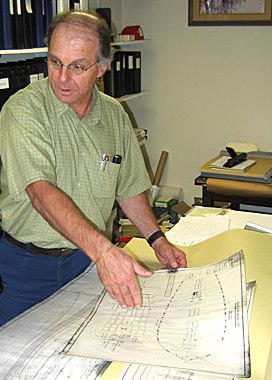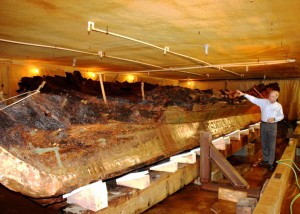Division bids farewell to Curator of Archaeology Chuck Fithian
On June 30, 2014, Chuck Fithian, Division of Historical and Cultural Affairs’ curator of archaeology, left the agency after a 28-year tenure. Beginning in August he will begin a new career-chapter as a lecturer in anthropology at Washington College in Chestertown, Md. The following article explores one of the passions that Fithian developed during his years of service at the division—his work in the conservation and documentation of His Majesty’s Sloop of War DeBraak, a British vessel that sank off the Delaware coast on May 25, 1798.
When Chuck Fithian began full-time work as site supervisor of the Division of Historical and Cultural Affairs’ Island Field Museum and Research Center in July 1986, he felt well on the way to cementing his career as a professional historian and archaeologist. Not only was he managing the museum, the site of a 1,000-year-old Native American burial ground, he was also responsible for the curation of the state’s substantial archaeological collections which were then housed at the museum.

Fithian had certainly come a long way since his graduation in 1977 with a bachelor’s degree in history from Salisbury State College in his hometown of Salisbury, Md. After a number of youthful work experiences, he had served, between 1981 and 1986, as an interpreter and then as an archaeologist at Historic St. Mary’s City, a museum of history and archaeology located in Maryland’s first capital. Along the way, he met his wife Diane, who he married in 1984. Now the couple had moved to Delaware and were in the process of building their lives together. It seemed like things could not get any better—but then they did!
In August 1986, one month after Fithian started his new job, a private salvage company raised the hull of the 18th-century British sloop of war DeBraak from the ocean floor off Lewes, Del. While the operation was a bust for the owners of the salvage company who had anticipated recovering stores of gold and silver, it was a find of the highest order for archaeologists and historians. Altogether, more than 20,000 artifacts were recovered from the shipwreck site including approximately one-third of the ship’s lower hull. After maintaining passive custody of this collection between 1986 and 1992, the state of Delaware purchased it outright from the salvage company in 1992.
Fithian could not believe his good fortune. He had long held an interest in British and American naval history and suddenly, out of nowhere, he had direct access to one of the most important collections of 18th-century Royal Navy artifacts anywhere in the world. He had found a passion that would occupy him for the next 28 years.
Fithian jumped into the project, working tirelessly with his division colleagues to conserve and document the collection. One particularly daunting problem was the conservation of the ship’s hull which had been preserved for almost 200 years on the ocean floor by submersion in cold water and burial in sand. If the hull’s water-logged timbers had been allowed to dry, their cellular structure would have collapsed causing them to break apart. The solution was to immerse the hull in water, and later, to devise a hydration system that sprayed it at regular intervals, keeping it saturated and preventing its wooden components from disintegration.
In addition to conservation, Fithian led the division’s efforts in researching the history of the ship and its context in the late-18th century Atlantic World. This research, which has continued over the past 28 years, helped burnish Fithian’s reputation as one of the region’s foremost experts on 18th and early-19th century British and American naval history. In addition to welcoming scholars from all over the world to the DeBraak’s conservation facilities, Fithian hosted Peter Weir, director of the 2003 historical film “Master and Commander: The Far Side of the World,” which depicts Napoleonic-era naval warfare. Fithian became a consultant for the film which went on to win two Academy Awards.
Beginning in 2011, Fithian led division efforts to further enhance the long-term conservation and preservation of DeBraak including the creation of an improved support-system to contain the hull and the addition of a filtration system that regularly cleans the water used to keep the hull wet. These improvements made it possible for the state of Delaware to begin offering public tours of the DeBraak hull in June 2012. True to form, Fithian led the tours of the hull from their inauguration until his last day of work at the division on June 30, 2014.

In the process of conducting these tours, Fithian discovered that he had a heretofore unrecognized talent and passion for teaching. He loved how his knowledge and experience could be used to transport people back to an earlier era, and he was gratified to see how his work could inspire people to appreciate the value of history and archaeology. With one door closing, another was opening for him.
In August 2014, Fithian will continue this new chapter in his life at Washington College where he will be teaching an introductory course on environmental archaeology “and any other courses that they want me to do.” In addition to teaching, he’ll be able to spend more time in research, and in documenting and publishing the results of his 30-plus year career as a historian and archaeologist. One thing won’t change however—his passion for the DeBraak. He plans to continue conducting research on the vessel and to volunteer weekly in its ongoing conservation.

Postscript:
Chuck Fithian had many other accomplishments during his tenure with the Delaware Division of Historical and Cultural Affairs. Any one of these could have been the subject of a full article. Following is only a partial listing of his many achievements: Research on the material-culture and social history of Colonial- and Revolutionary War-era America; survey of Delaware sites related to the War of 1812; and research and consultation on the design of the Delaware Continental-soldier memorial in Dover, Del., and the monument at Gettysburg National Military Park commemorating the contributions of the 1st and 2nd Delaware infantry regiments. Fithian holds a Master in History from Salisbury University and is the recipient of that institution’s Wroten Award which honors individuals that have made a significant contribution to written scholarship about the colonial Eastern Shore.


